
St Thomas - photos of people, places and events
Page updated 21st March 2014
Back to Photo Essays
The second of several pages for the different areas of Exeter. If you have a photo of a place, event or people in St Thomas, that would be suitable for inclusion on the page, or know more about one of the photographs, please Contact me.
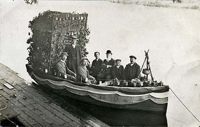 A decorated boat for the St Thomas ARC
that took part in the 1912 water carnival.
A decorated boat for the St Thomas ARC
that took part in the 1912 water carnival.
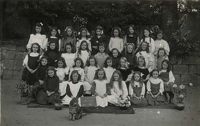 St Thomas Girls' 1910 is chalked
on
the board.
St Thomas Girls' 1910 is chalked
on
the board.
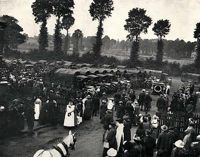 In October 1914, a Canadian Motor
Transport detachment of motorised machine-guns and supply column
passed up Alphington Street and Cowick Street, watched by a large
crowd. They camped at Fairfield in Okehampton Road for the night before
driving over the Exe Bridge and up Fore Street, and proceeding to
their destination. Photo courtesy the Westcountry Studies Library.
In October 1914, a Canadian Motor
Transport detachment of motorised machine-guns and supply column
passed up Alphington Street and Cowick Street, watched by a large
crowd. They camped at Fairfield in Okehampton Road for the night before
driving over the Exe Bridge and up Fore Street, and proceeding to
their destination. Photo courtesy the Westcountry Studies Library.
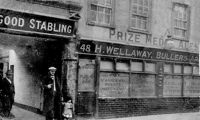 The
Buller Arms in Alphington Street was the first to apply for
permission to put up a sign that said "Motor Accommodation". The
Council approved the sign on 23rd March 1904. Photo Simon Wellaway.
The
Buller Arms in Alphington Street was the first to apply for
permission to put up a sign that said "Motor Accommodation". The
Council approved the sign on 23rd March 1904. Photo Simon Wellaway.
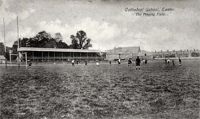 A postcard showing the County
Ground when it was being used for a rugby match by the Cathedral School.
A postcard showing the County
Ground when it was being used for a rugby match by the Cathedral School.
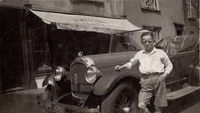 The shop of Hubert Wellaway, a
fruiterer of 144 Cowick
Street. Hubert had previously been the landlord of
the Bullers Arms in Alphington Street. Photo Simon Wellaway.
The shop of Hubert Wellaway, a
fruiterer of 144 Cowick
Street. Hubert had previously been the landlord of
the Bullers Arms in Alphington Street. Photo Simon Wellaway.
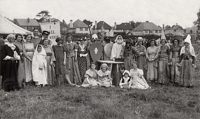 A second photo of the pageant
held at Franklyn House. Photo John Moore.
A second photo of the pageant
held at Franklyn House. Photo John Moore.
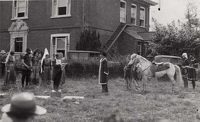 During the middle of the 1930s
a pageant was held at Franklyn House, probably as part of the St Thomas
Fête. Photo John Moore.
During the middle of the 1930s
a pageant was held at Franklyn House, probably as part of the St Thomas
Fête. Photo John Moore.
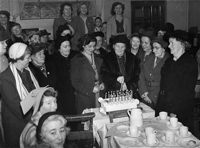 The St Thomas Townswoman's
Guild meet in the Methodist Hall during the early 1950s. The cake
cutter is the president, Mrs Fanny Lethbridge. Photo Tony Lethbridge.
The St Thomas Townswoman's
Guild meet in the Methodist Hall during the early 1950s. The cake
cutter is the president, Mrs Fanny Lethbridge. Photo Tony Lethbridge.
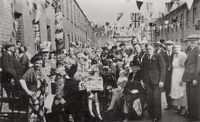 The
Coronation of King George VI in May 1937 was a time for celebrations in
many streets across the land. The people of St Thomas turned out in
their droves, placed tables and benches in the streets and laid on a
tea for the children and a drink for the adults. I'm not certain where
this photo was taken, apart from St Thomas. Photo John Garnsworthy.
The
Coronation of King George VI in May 1937 was a time for celebrations in
many streets across the land. The people of St Thomas turned out in
their droves, placed tables and benches in the streets and laid on a
tea for the children and a drink for the adults. I'm not certain where
this photo was taken, apart from St Thomas. Photo John Garnsworthy.
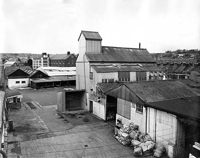 Before the Gateway Shopping Centre
(now Somerfield) was built in Cowick Street, a large rectangular area
from the shop fronts to the rope walk was owned by French's Mill and
Seed Merchants. The large building in this photo was the cubing mill,
and behind is Wippell's in Buller Road. The mill was sited just
where the row of shops is now situated at the rear of the car park.
Photo Murray French.
Before the Gateway Shopping Centre
(now Somerfield) was built in Cowick Street, a large rectangular area
from the shop fronts to the rope walk was owned by French's Mill and
Seed Merchants. The large building in this photo was the cubing mill,
and behind is Wippell's in Buller Road. The mill was sited just
where the row of shops is now situated at the rear of the car park.
Photo Murray French.
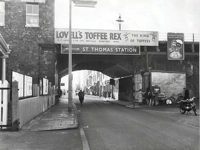 St
Thomas railway bridge before Cowick Street was widened and a pedestrian
arch made parallel to the road arch. Circa 1955. The small hut like
shop to the right of the arch was Paddy Lawler's Emporium. Paddy would
have all sorts of junk for sale. For many years he had a large stuffed
bear that would be put out the front, often wearing a corset or pair of
bloomers, or similar, of which he had managed to find a plentiful
supply, for sale. At night, the bear, being too large to go in the shop
was put around the back and covered with a tarpaulin. Many a young
police constable was given a scare by a senior colleague, by being
asked to investigate the rear of the building on a dark night. See Willie the Transport Manager. Photo
Express and Echo and memories of Peter Hinchliffe.
St
Thomas railway bridge before Cowick Street was widened and a pedestrian
arch made parallel to the road arch. Circa 1955. The small hut like
shop to the right of the arch was Paddy Lawler's Emporium. Paddy would
have all sorts of junk for sale. For many years he had a large stuffed
bear that would be put out the front, often wearing a corset or pair of
bloomers, or similar, of which he had managed to find a plentiful
supply, for sale. At night, the bear, being too large to go in the shop
was put around the back and covered with a tarpaulin. Many a young
police constable was given a scare by a senior colleague, by being
asked to investigate the rear of the building on a dark night. See Willie the Transport Manager. Photo
Express and Echo and memories of Peter Hinchliffe.
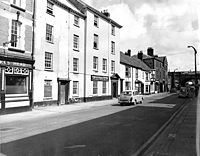 This is the only photo I have of the Turks Head, which was on the north side of Cowick Street. It is now the entrance road into St Thomas precinct, with the General Buller, just behind. Other pubs in this view are the Moreton Arms and the Railway Inn.
This is the only photo I have of the Turks Head, which was on the north side of Cowick Street. It is now the entrance road into St Thomas precinct, with the General Buller, just behind. Other pubs in this view are the Moreton Arms and the Railway Inn.
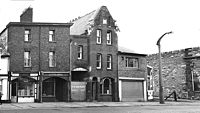 The north side of Cowick Street by the railway viaduct. The Railway Inn was just behind the lamp post – it was a City Brewery house that was closed in 1939, and demolished after the war. The National Westminster Bank is now on this site.
The north side of Cowick Street by the railway viaduct. The Railway Inn was just behind the lamp post – it was a City Brewery house that was closed in 1939, and demolished after the war. The National Westminster Bank is now on this site.
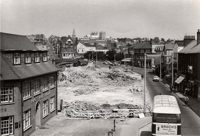 The new road layout for the
twin Exe Bridges included widening Cowick and Alphington Street. They
started on the northern side of Cowick Street, leaving the King's Arms in situ, as it had been rebuilt a few years before, a few yards behind
the old building line. In this photo, all the shops and tenements on
that
side, including Swan Yard have been bulldozed before the road is
widened. Photo Express and Echo.
The new road layout for the
twin Exe Bridges included widening Cowick and Alphington Street. They
started on the northern side of Cowick Street, leaving the King's Arms in situ, as it had been rebuilt a few years before, a few yards behind
the old building line. In this photo, all the shops and tenements on
that
side, including Swan Yard have been bulldozed before the road is
widened. Photo Express and Echo.
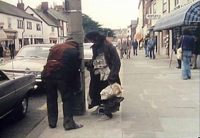 Cowick Street
became a famous land mark when the Monty Python team decided to film
part of a sketch in the street. Entitled 'Up you street' it featured
two tramps who find a bottle of champaign and two glasses in a rubbish
bin. See
Cowick Street
became a famous land mark when the Monty Python team decided to film
part of a sketch in the street. Entitled 'Up you street' it featured
two tramps who find a bottle of champaign and two glasses in a rubbish
bin. See  Up Your
Street
Up Your
Street
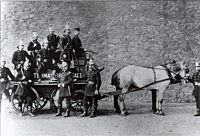 St Thomas was incorporated into Exeter in 1899. Before then, it had its own fire service. This is the fire-wagon and crew in 1889.
St Thomas was incorporated into Exeter in 1899. Before then, it had its own fire service. This is the fire-wagon and crew in 1889.
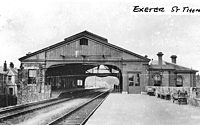 St Thomas Station was the headquarters of the South Devon Railway, and as such, it had to have a building to suit its status. There was a grand entrance at street level while it was fully enclosed at the platform.
St Thomas Station was the headquarters of the South Devon Railway, and as such, it had to have a building to suit its status. There was a grand entrance at street level while it was fully enclosed at the platform.
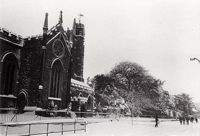 St Thomas Church and Cowick
Street after the great blizzard of February 1978. Photo John
Garnsworthy.
St Thomas Church and Cowick
Street after the great blizzard of February 1978. Photo John
Garnsworthy.
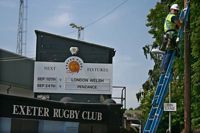 The entrance to the County Ground
in 2005, just before the Exeter Chiefs played their last game there.
Everything has now gone, as the developers have started building the
new houses (2009)
The entrance to the County Ground
in 2005, just before the Exeter Chiefs played their last game there.
Everything has now gone, as the developers have started building the
new houses (2009)
│ Top of Page │